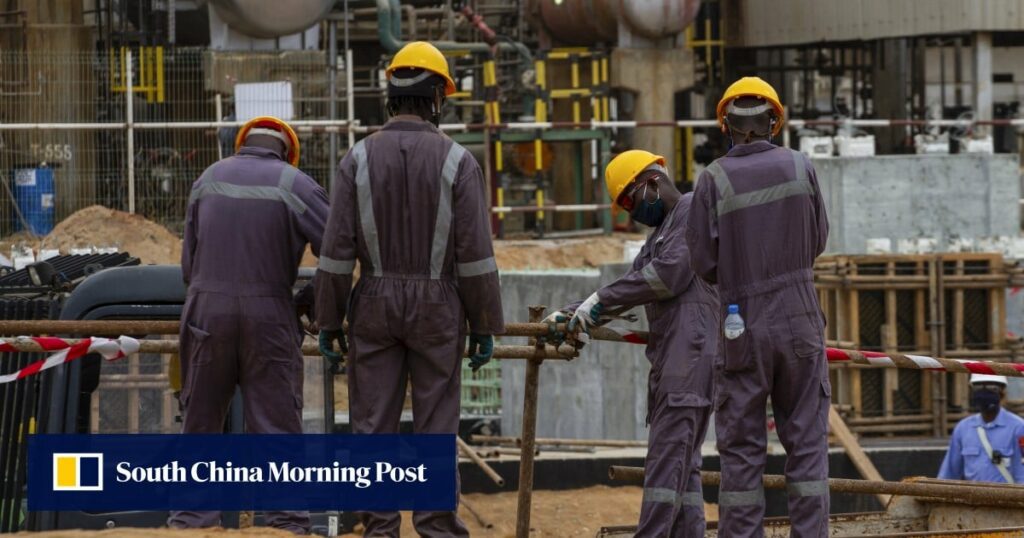Angola used oil shipments to repay some of its resource-backed loans. But when prices fell, it was forced to pump more oil to service its debts, a policy that has become untenable.
According to Boston University data, between 2000 and 2022 Angola borrowed US$45 billion from China – about a quarter of total Chinese lending to African countries.
Crude oil production in most African countries like Angola has dropped over the years due to a lack of investment in equipment and new oilfields.
As China’s oil imports from Africa decline, it is increasingly turning to the more predictable production infrastructure of the Gulf countries and Russia, according to the report from Carnegie, a Washington-based think tank.
It said the value of crude oil imports from Russia and most Asian producers in 2023 had increased from 2019 pre-pandemic levels.
“Imports increased by over 40 per cent for nearly all of China’s top oil trade partners in Asia, with the exception of Iran, whose oil is transshipped via countries such as the United Arab Emirates (UAE) and Malaysia,” the report said.
Africa once accounted for more than a third of Chinese oil imports. But by 2022, that figure had dropped to about one-tenth, according to the Observatory of Economic Complexity (OEC), an online data platform.
The Carnegie report said that, between 2019 and 2023, there were dramatic increases in China’s imports of oil from the UAE (254 per cent), Malaysia (408 per cent), Kazakhstan (214 per cent) and Kuwait (41 per cent).
01:21
China-built hydropower station in Angola enters main construction phase
China-built hydropower station in Angola enters main construction phase
In Africa, the picture was almost the complete opposite. With the exception of Chad, which saw a 78 per cent increase in the value of oil exports to China during the same period, all of the other eight major African oil producers earned much less than they did before the pandemic, according to the report.
South Sudan, Sudan and Nigeria, for instance, saw declines of as much as 77 per cent, 67 per cent and 61 per cent, respectively.
There were a number of factors driving the drop in Chinese oil imports from Africa, observers said, including geopolitical considerations, infrastructure issues and domestic political problems.
Lara Wolfe, a senior country risk analyst for sub-Saharan Africa at BMI, part of Fitch Solutions, said the recalibration of China’s crude oil imports was a reflection of both supply-side constraints and strategic geopolitical manoeuvring.
She said a downturn in African production, mainly due to issues such as ageing infrastructure, underinvestment, and in some cases political instability, had naturally reduced export capabilities, therefore limiting the volume of crude oil that China could buy.
Amid these African supply issues, China had been fortifying its ties with GCC countries, specifically the UAE, and increasing imports from Russia, Wolfe said.
The preference for Russian oil may be partly aimed at supporting the Russian economy amid international sanctions, while securing potentially favourable termsLara Wolfe, sub-Saharan Africa risk analyst
She said the enhanced relationship with the UAE was probably due to both the stability of supply and deepening economic connections, as demonstrated by several deals with the Abu Dhabi National Oil Company. But the shift also reflected the UAE’s logistical advantages and political reliability.
Meanwhile, “the preference for Russian oil may be partly aimed at supporting the Russian economy amid international sanctions, while securing potentially favourable terms”, Wolfe said.
“It is a strategic repositioning that is likely to persist, as mainland China continues to navigate the global geopolitical landscape and seeks to ensure the reliability and security of its energy supply.”
Luke Patey, a researcher at the Danish Institute for International Studies, said the shift could be explained by geopolitical and geological factors.
“Russia’s isolation in the West has similarly increased its role as a major oil supplier to China,” Patey said. He said the rise of Malaysia and the UAE, for example, was a consequence of transshipment of Iranian oil to China to avoid US sanctions.
Ageing oilfields had caused a decline in crude output over the past decade among many African producers, including the big players like Nigeria and Angola, Patey noted, while other suppliers to China, such as Sudan and South Sudan, had seen production disrupted by conflict.
“Without stability and significant investment in secondary recovery of mature oilfields, it’s a trend that is set to continue,” Patey said.
“Trade is still largely unbalanced in China’s favour, with African countries exporting very little to the Chinese market beyond oil and minerals, resembling [Africa’s] historical relationship with the West,” Patey said.
Mark Bohlund, a senior credit research analyst at REDD Intelligence, said the drop in African oil flow to China could largely be explained by Middle Eastern oil exporters competing more aggressively for market share in Asia, as the United States, traditionally their main export market, had become more self-reliant due to the shale oil revolution – procured through the process known as fracking.
This had been done by offering bigger discounts to Asian consumers, Bohlund said.
Also, the production volumes of major players like Angola, Nigeria and Sudan or South Sudan had all fallen due to insufficient investment, which meant that new oilfields coming online had not been sufficient to cover for the shortfall from maturing fields, Bohlund said.
“I expect this development to continue in the near term even if we see higher production volumes from some African countries like Ivory Coast, Gabon, Senegal and Uganda,” he said.
While Chinese oil producers were involved in many of these development projects, Bohlund said, much of the new output was likely to go to Europe and other markets.
“I see a higher likelihood that liquid natural gas output from Mozambique and Tanzania will go to Asian markets over the medium term, but will still have a smaller market share than Qatar and other producers.”
Source link : https://amp.scmp.com/news/china/diplomacy/article/3265800/angola-model-over-china-buys-more-crude-oil-gulf-and-russia-africa
Author :
Publish date : 2024-07-07 09:00:08
Copyright for syndicated content belongs to the linked Source.
